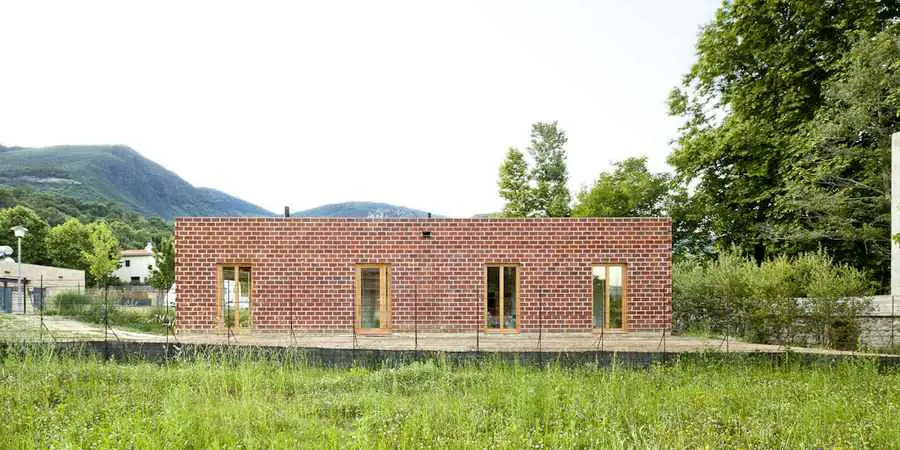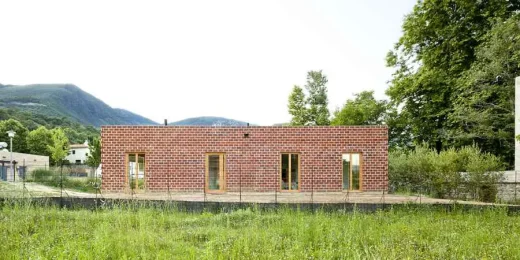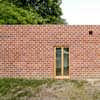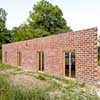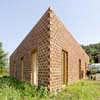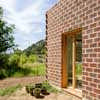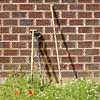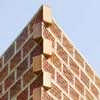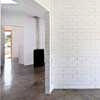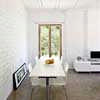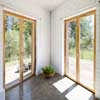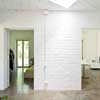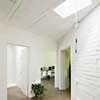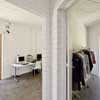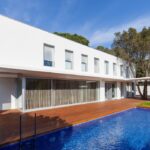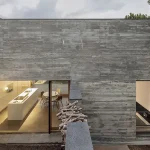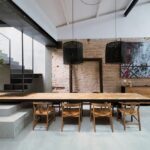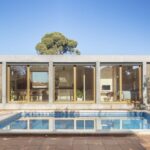Casa 712 Barcelona property, Gualba home design, Catalan house photos, New Spanish residence
Casa 712 Catalunya : Gualba House
Spanish residential building design by H Arquitectes, Spain
post updated 10 May 2024
House 712, Gualba, Barcelona, Spain
2011
Design: H ARQUITECTES
Photos: Adrià Goula Sardà
English text (scroll down for Spanish):
House in Gualba
24 Nov 2011
Casa Gualba
SUMMARY
The house was for a young couple without children, and had some initial programmatic requirements which were pretty conventional (a garage, three bedrooms, a study, etc). The plot, which was triangular and around 400m2, was part of a land promotion protected by the Incasol for self promoters and was subjected to a tight schedule for the development of the house.
While designing the project, both the clients’ requirements as well as our own ones had to be redefined so that the final price could be lowered while respecting most of the specifications of the couple, the land and the (social and economical) context. During this process the cost was reduced to 65%.
Firstly, it was decided not to take any action in relation to the plot; the idea of concentrating exterior space in any of the facades had to be relinquished since this strategy needed a two-floor building and it was understood that in order to meet both the building and the economical objectives a ground-floor building was needed… this volumetric sacrifice implied a programmatic one: there would be no garage, no hall and just one bathroom.
The triangular geometry of the plot was assumed and a systematic distribution was established based on two basic and equivalent spaces which were only qualified according to its orientation and its relationship with the exterior: three spaces from 8 to 10 m2 and three from 15 to 18m2. All of them on facade and based around a central triangular space which had not been programmed before, but which had surface enough to assume unforeseeable uses (storage room, summer dining room, study, bicycles…).
Taking into account the willingness of working with an economic system of load bearing walls working on pure compression, a technology which could be assumed by any traditional builder was designed and any building system which was not available to any of the interlocutors was discarded.
Although the strict budget control which had been carried out, at the time of asking for credit facilities, the clients met with the banks ‘refusal of providing the initially foreseen 250.000 €. From that moment, a process of revision, simplification of technologies and the total elimination of coverings was carried out; therefore, the budget was lowered to the final 120.000 €, with the builder’s approval.
The house was built with a double wall made of perforated bricks with an air chamber, with the structural wall in the internal side in order to avoid thermal bridges. This wall, which had the perforated bricks arranged to be seen, was based, together with the interior load bearing walls on an oversized insulating suspended ground floor, which allowed us having the concrete paving completed before the building of the walls. Thanks to this action, the joints were hidden and the difficulties which usually arise from building concrete paving a posteriori were avoided.
The closing exterior wall, -the facade-, was made with the same perforated bricks at full sight but turned round, with the holes facing outside; this means the facade is ventilated and there’s a cavity that easily drains the water thanks to the bricks’ geometry. The deck framework has small beams and joists strictly lying on the load bearing walls in order to avoid the transmission of bending momentum to the wall structure. The deck was protected with recycled material of ceramic waste from same the building works.
As for the openings, only the rooms which were furnished as bedrooms (two of them) were closed with wooden sheets put on top of (and not fitted in) the load bearing walls. All the vertical installations for electricity and data were left at sight, hiding the horizontal ones into the concrete deck slopes.
Finally, all the interior ceramic works were painted white.
Outside, in order to level and slightly flatten the land, a system of reinforced earth walls was used and with its corrugated steel beams a light fence which will act as a stand for the vegetation was built.
Casa 712 – Building Information
Name of work: HOUSE 712
Situation: Gualba, Barcelona
Author: H ARQUITECTES (David Lorente, Josep Ricart, Xavier Ros, Roger Tudó)
Collaborators: Montse Fornés, architect (Harquitectes) Anna Bonet, interiorista (Harquitectes) Iñaki González de Mendiguchia, technical architect
Year of realization: 2008-11
Surface constructed: 127,40 m2
Budget: 130.000€
Constructor: Construcciones Jufraed 2001, S.L.
Spanish text:
MEMORIA
La casa era para una pareja joven sin hijos, con unas demandas programáticas iniciales bastante convencionales (garaje, tres habitaciones, estudio, etc.). La parcela, triangular y de unos 400 m2, formaba parte de una promoción de suelo protegido para autopromotores del Incasòl y estaba sujeta a un calendario fijado para el desarrollo de la casa.
El processo proyectual se basó en una reducción continúa de las demandas de los clientes, y de nosotros mismos, para disminuir el precio final de la casa sin dejar de reconocer las especificidades de la pareja, del solar y del contexto (geográfico y económico). Durante este processo de renuncias el coste se redujo a menos de la mitad.
La primera decisión fue no hacer ningún gesto respecto al solar, renunciamos a concentrar espacio exterior en alguna de las fachadas, puesto que esta estrategia pasaba necesariamente por una vivienda de dos plantas, y entendíamos que para lograr los objetivos constructivos y económicos hacía falta sólo planta baja… esta renuncia volumétrica implicaba una renuncia programática: no habría garaje, no habría vestíbulo y no habría más que un baño.
Asumimos la geometría triangular del solar y establecimos una distribución sistemática a partir de dos tipos de espacios básicos equivalentes, que sólo se calificaban en función de su orientación y relación con el exterior: tres espacios de 8 a 10 m2 y tres de 15 a 18 m2. Todos ellos en fachada, alrededor de un espacio central triangular no programado pero con una superficie suficiente para asumir usos no previstos (almacén, comedor de verano, estudio, bicis).
La voluntad de trabajar con un sistema económico de muros, que trabajaran a compresión, se concretó con una tecnología asumible para un albañil tradicional y “de pueblo”, evitando cualquier sistema constructivo que no estuviera al alcance de un único interlocutor. A pesar del control presupuestario, a la hora de pedir financiación, los clientes se encontraron con la negativa de los bancos para financiar los 250.000 euros previstos inicialmente, a partir de ahí se inició un processo de revisión, (todavía más) simplificación de las tecnologías y eliminación implacable del revestimientos y acabados prescindibles, que nos permitió, con la aprobación del albañil, ajustar el presupuesto hasta los 120.000€ finales.
La casa se construyó con una doble hoja con cámara, con el muro estructural en la hoja interior para evitar puentes térmicos. Este muro, de gero colocado para quedar visto, cómo el resto de muros de carga interiores, se construye encima del forjado sanitario, sobredimensionado para soportar un pavimento de hormigón que se completó antes de iniciar la construcción de las paredes, ocultando juntas y evitando las dificultades de aplicación que implica un pavimento de hormigón a posteriori. La fachada se realizó con el mismo ladrillo gero visto pero girado, con los agujeros a la vista, configurando una fachada ventilada con una cámara que drena las aguas muy fácilmente por geometría. En el forjado de la cubierta se dejaron viguetas y bovedillas vistas estrictamente apoyadas en los muros de carga, para evitar la transmisión de momentos a la estructura mural. La cubierta se protegió con el material reciclado obtenido de los residuos cerámicos generados por la misma obra. En cuanto a los ventanales, sólo los espacios amueblados como habitación (dos piezas) se cerraron con carpinterías superpuestas (no encajadas) a las paredes de carga.
Todas las instalaciones verticales de electricidad y de datos se dejaron vistas, ocultando las horizontales en el hormigón de pendientes de la cubierta.
Finalmente se pintó toda la fábrica cerámica interior de color blanco.
Al exterior, para nivelar y allanar ligeramente el terreno se utilizó un sistema de muros de tierra armada, y con las mismas barras de acero corrugado se realizó una valla muy ligera que servirá de apoyo para la vegetación.
Casa 712 – Ficha Técnica
Titulo de la obra: CASA 712
Situación: Gualba, Barcelona
Autor: H ARQUITECTES (David Lorente, Josep Ricart, Xavier Ros, Roger Tudó)
Colaboradores: Montse Fornés, arquitecta (Harquitectes) Anna Bonet, interiorista (Harquitectes) Iñaki González de Mendiguchia, arquitecto técnico
Promotor: Carmen Guiral, Jorge Efrén Sánchez
Año de realización: 2007-11
Superficie construida: 127,40 m2
Coste de la obra: 120.000€
Terminio de ejecución de la obra: 2010-11
Constructora: Construcciones Jufraed 2001, S.L.
Casa 712 Photos: Adrià Goula Sardà
Casa 712 images / information from H ARQUITECTES
Casa 712 Architects : H ARQUITECTES
Location: Gualba, Barcelona, Catalunya, North East Spain, south western Europe
Barcelona Architectural Designs
Barcelona Architectural Designs – latest buildings
Recent Barcelona Houses
Casa, Les Franqueses del Vallés
CPVA Arquitectes
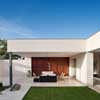
picture : Simon Garcia
Les Franqueses del Vallés house
Casa M
RTA-Office
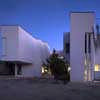
picture from architects
Casa M Barcelona
Casa 101, Mollet del Vallès, Catalunya
H ARQUITECTES
Catalonian house
Casa 108, Rosamar, Costa Brava
H ARQUITECTES
Costa Brava house
Casa 205, Vacarisses, Catalunya
H ARQUITECTES
Vacarisses house
Comments / photos for the Casa 712 Barcelona design by H Arquitectes page welcome

